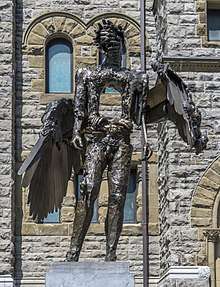David Altmejd
David Altmejd (born 1974) is a Canadian sculptor who lives and works in New York City. Altmejd creates highly detailed sculptures that often blur the distinction between interior and exterior, surface and structure, figurative representation and abstraction. His work has appeared in major exhibitions at the Royal Museums of Fine Arts of Belgium, Brussels (2016), Louisiana Museum of Modern Art, Humlebaek (2015), Mudam Luxembourg, Musée d’art moderne Grand- Duc Jean, Luxembourg (2015 - 2016), Musée d’Art Moderne de la Ville de Paris, Paris (2015), MOCA Cleveland, Cleveland (2012), the Brant Foundation Art Study Center (2011), the National Gallery of Canada, Ottawa (2010), the New Museum (2010) and the Solomon R. Guggenheim Museum (2010).

Life and work
Born in Montreal, Quebec, Altmejd earned a Bachelor of Fine Arts from the Université du Québec à Montréal.[1] Altmejd completed his Masters of Fine Arts at Columbia University in 2001.
Since graduating with his MFA, he has taken part in many group shows, such as at Artists Space and Deitch Projects. In 2003, he was curated by Dan Cameron into the 8th International Istanbul Biennial. In 2004, he was included in the Whitney Biennial of American Art.
In 2007, he represented Canada at the Venice Biennale; his installation "The Index" (curated by Louise Déry) was subsequently purchased by the Art Gallery of Ontario.[2] The Greek collector Dakis Joannou purchased the other half of the installation.[3]
Altmejd's sculptures mix seemingly random objects such as decapitated werewolf heads with graffiti-style Stars of David, towers made of mirrors, plastic flowers and costume jewelry, to create sculptural systems loaded with what he calls "symbolic potential" and open ended narratives. Werewolf heads have appeared so frequently in his work that in the contemporary art world, they are widely recognized as being closely affiliated with this artist. They featured prominently in his solo show at the Brant Foundation in 2012. [4]
Kara L. Rooney writes of "The Vessel" (2011), the central piece in his March 2011 showing at Andrea Rosen Gallery:
Like Altmejd's figurative giants, 'The Vessel' contains a myriad number of small universes that lodge themselves like secrets in pockets of flesh and plastic. Lengths of fine gold chain, Plasticine hands and ears, shards of mirror and quartz, spools of multi-colored thread, seahorse and insect casts, as well as abstracted references to Avian gods, such as cranes and other airborne creatures, swarm the Plexi castle in a cacophony of frozen movement.[5]
In 2016 Altmejd designed the art for Yeasayer's album Amen & Goodbye which the band described as "Sgt Pepper meets Hieronymous Bosch meets Dali meets PeeWee's Playhouse."[6]
He is represented by White Cube and Xavier Hufkens.
Documentary
- 2012 - Chaorismatique, David Altmejd, sculpteur (dir. Rénald Bellemare)
Notes and references
- David Altmejd Bio
- "AGO Receives Acclaimed Canadian Contemporary Sculpture". Art Gallery of Ontario, Press release. 20 August 2007. Retrieved 2009-06-15.
- Sarah Thornton. Seven Days in the Art World. New York. ISBN 9780393337129. OCLC 489232834.
- Bregman, Alexandra (25 March 2015). "AO On Site – Greenwich, Connecticut: David Altmejd at The Brant Foundation through March 31, 2012". Art Observed. Retrieved 2015-04-12.
- Rooney, Kara L. (May 2011). "David Altmejd". The Brooklyn Rail.
- http://www.transversomedia.com/articles//take-a-bizarre-trip-through-yeasayers-amen-goodbye-album-art-in-new-music-video-for-unnamed-single
External links
| Wikimedia Commons has media related to David Altmejd. |
- David Altmejd : Official website
- Xavier Hufkens: David Altmejd
- White Cube
- Musée d'Art Moderne de la Ville de Paris: David Altmejd
- Louisiana Museum of Modern Art: David Altmejd
- Royal Museums of Fine Arts Belgium: David Altmejd
- Interview (2007)
- An Interview with David Altmejd by Randy Gladman from C International Contemporary Art Magazine, Summer 2004.
- Venice Biennale (2007): David Altmejd ry,
- Glenbow: David Altmejd : The Vessel